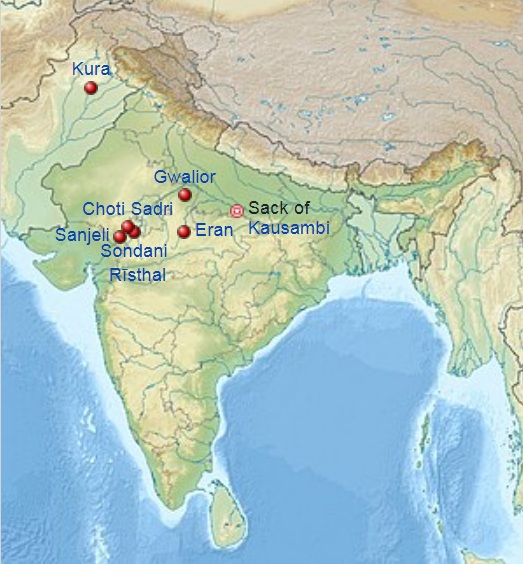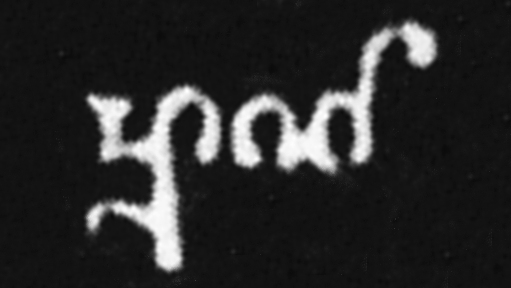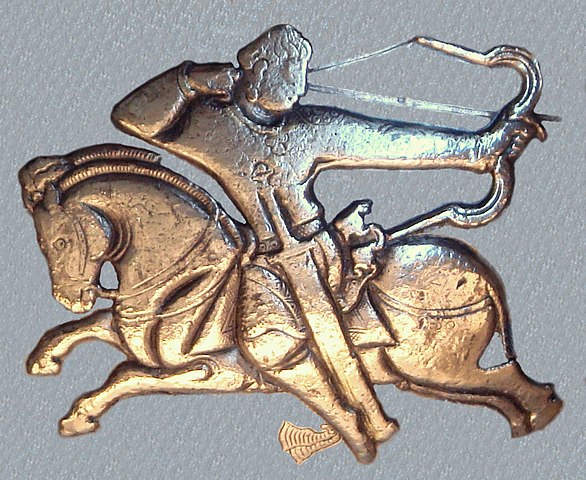
| HUN
Find spots of inscriptions related to local control by the Alchon Huns (map of the Indian subcontinent) Huns or Hun was the name given by the ancient Indians to a group of Central Asian tribes who, via the Khyber Pass, entered India at the end of the 5th or early 6th century. Hun Kingdom occupied areas as far as Eran and Kausambi, greatly weakening the Gupta Empire. The Huns were ultimately defeated by the Indian Gupta Empire and the Indian king Yasodharman.
The Huns are thought to have included the Xionite and/or Hephthalite, the Kidarites, the Alchon Huns (also known as the Alxon, Alakhana, Walxon etc.) and the Nezak Huns. Such names, along with that of the HaraHuns (also known as the HalaHuns or Harahuras) mentioned in Hindu texts, have sometimes been used for the Huns in general; while these groups (and the Iranian Huns) appear to have been a component of the Huns, such names were not necessarily synonymous. The relationship, if any, of the Huns to the Huns, a Central Asian people who invaded Europe during the same period, is also unclear.
The Kidarites, who invaded Bactria in the second half of the 4th century, are generally regarded as the first wave of Huns to enter South Asia.
Gujars are sometimes said to have been originally a sub-tribe of the Huns.
In its farthest geographical extent in India, the territories controlled by the Huns covered the region up to Malwa in central India. Their repeated invasions and war losses were the main reason for the decline of the Gupta Empire.
The Indian word "Hun" in line 12 (Verse 16) of the Risthal inscription, 6th century CE The Mongolian-Tibetan historian Sumpa Yeshe Peljor (writing in the 18th century) lists the Huns alongside other peoples found in Central Asia since antiquity, including the Yavans (Greeks), Kambojs, Tukhars, Khass and Darads.
Chinese sources link the Central Asian tribes comprising the Huns to both the Xiongnu of north east Asia and the Huns who later invaded and settled in Europe. Similarly, Gerald Larson suggests that the Huns were a Turkic-Mongolian grouping from Central Asia. The works of Ptolemy (2nd century) are among the first European texts to mention the Huns, followed by the texts by Marcellinus and Priscus. They too suggest that the Huns were an inner Asian people.
Hephthalite horseman on British Museum bowl, 460–479 CE. According
to Procopius of Caesarea, they were of the same stock as European
Huns "in fact as well as in name", but sedentary and white-skinned.
The Ephthalitae Huns, who are called White Huns. The Ephthalitae are of the stock of the Huns in fact as well as in name, however they do not mingle with any of the Huns known to us, for they occupy a land neither adjoining nor even very near to them; but their territory lies immediately to the north of Persia. They are not nomads like the other Hunnic peoples, but for a long period have been established in a goodly land... They are the only ones among the Huns who have white bodies and countenances which are not ugly. It is also true that their manner of living is unlike that of their kinsmen, nor do they live a savage life as they do; but they are ruled by one king, and since they possess a lawful constitution, they observe right and justice in their dealings both with one another and with their neighbours, in no degree less than the Romans and the Persians.
The Kidarites, who invaded Bactria in the second half of the 4th century, are generally regarded as the first wave of Huns to enter South Asia.
Religion :
Song Yun and Hui Zheng, who visited the chief of the Hephthalite nomads at his summer residence in Badakshan and later in Gandhar, observed that they had no belief in the Buddhist law and served a large number of divinities."
Source :
https://en.wikipedia.org/ |


